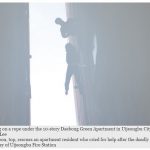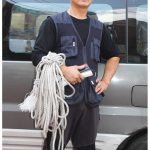20151113 Korea Manual laborer saves 13 people from deadly fire

Korea Nov 13 2015 “Apartment houses”
Dead : dead 5 to 9 Burnout : 0 or unknown Injured : injured more than 10
Manual laborer saves 13 people from deadly fire
Updated: 2015-11-13 18:35
UIJEONGBU, Gyeonggi Province — Unbeknownst to Lee Seung-seon, the man who saved the lives of 13 people from the deadly fire last Jan. 10 that killed 5 people and injured 125 others, his risky jobs in the past two decades had been preparing him to become a rescuer.
During the past 20 years, the 51-year-old acquired 39 vocational skills from fixing home electrical problems to hanging signboards while dangling on a rope under high-rise buildings.
His traumatic debt-ridden past had prompted him to acquire a comprehensive range of capabilities in order to support his family and at the same time repay his debts. And recently, these survival skills also helped him save the lives of people in danger.
“People feel extreme fear and horror when they are trapped in a fire. I know exactly how they feel because I had similar horrific experiences several times,” he told The Korea Times. “My legs were broken years ago when I fell from a high-rise building while doing my work. I had severe burns while doing welding. I had almost all the disastrous experiences people can go through in their lifetime.”

The fire began on the first floor of the 10-story Daebong Green Apartment building in the northeastern city of Uijeongbu on a Saturday morning and then quickly spread to nearby housings.
Lee was driving to work and was near the Uijeongbu railway station when, from a distance, he saw the massive cloud of black smoke rising in the air.
Instantly realizing that a disaster was happening, he drove his to the origin of the black smoke. Upon arriving, he saw that the entire apartment building was on fire and people inside the building were panicking, screaming and crying for help.
After seeing that several people were stuck on the third, sixth, seventh and eighth floors of the apartment building, he took an elevator to go to the rooftop. Then, hanging on a 30-meter rope following a gas pipe line from the rooftop, he moved to each of the above-mentioned floors and rescued people, tying them to the rope one after the other. With simply a rope and his arm strength, he was able to bring 13 people to safety.
Lee’s heroic act caused a media frenzy. He made the headlines of newspapers and news broadcasts. Along with seven others who helped effectively contain the massive fire, Lee was named a hero in February and received a medal from Gyeonggi Gov. Nam Kyung-phil. During the award ceremony, Gov. Nam asked Lee to show his right hand.
As he looked at it with wonder and admiration, the governor said 13 people were saved because of his hands. Nam also called Lee a patriot whose courage and sacrifice made the society robust.
Lee made an unusual proposal during his meeting with the governor. According to him, those who did a heroic act sometimes suffer afterward, especially when unintended results occur during their rescue efforts and when people criticize them when their efforts fail to save people’s lives. If this continues to happens, he said, people will be discouraged from doing heroic acts. Lee asked the provincial government officials to take measures to educate the public about respecting those who try to help people regardless of the outcome of their efforts.
Lee’s proposal came as his heroic act has become a source of disagreement with his wife. According to him, his wife has become angry and deeply concerned about the possible negative consequences of her husband’s courageous act in a time of a crisis.
“She and I kind of had a hard time trying to understand each other after the fire,” Lee said. “Although she knew that I did the right thing, she was deeply upset about the worst-case scenario.”
What if Lee died or suffered severe injuries after his rescue efforts? What if some of the people he was trying to rescue were injured or killed during the risky mission? These were the questions Lee’s wife raised as a source of her anger.
In addition, Lee’s rescue efforts reminded his wife of the couple’s traumatic debt-ridden experience that haunted them in the past two decades.
Last year, Lee’s family finally exited from the debt repayment program that they entered after he accidentally ran over a five-year-old girl 20 years ago. He was driving his 2.5-ton truck out of a parking lot near Uijeongbu Station on the night of the Lunar New Year. He had to pass through a narrow space between two vehicles that were parked there. Through a wing mirror, he saw a middle-aged woman walking behind his car. He gassed the pedal after making sure that the lady walked away. All of a sudden, a little child ran into his truck, causing the tragedy.
“It was neither my fault nor the little girl’s,” he said.
After the accident, he spent several days in a detention center until his and the victim’s families agreed on a huge settlement fee, for which he and his family borrowed money from friends, relatives and banks. After he was released from the detention center, he found a notebook that recorded all of his and his family’s debts. The tough times continued.
His business went bankrupt. There were no decent jobs that were available for him because he became a delinquent borrower. As the breadwinner, Lee was determined to work harder and longer than other people do in order to support his wife and two sons and repay their debts.
He did a variety of manual jobs. He accepted offers for precarious jobs, such as hanging signboards while dangling on a rope under high-rise buildings. Such jobs guarantee higher income because of the high safety risks they entail.
Lee also fixed waterproof devices, electrical equipment and home appliances. His experience in one manual job led him to acquire another skill, and this learning process continued as he expanded to other areas of expertise.
Those manual jobs not only helped him earn a relatively high income but also made him physically strong enough to perform risky rescue missions, such as saving people from a fire in a 10-story building using only a rope and his arm strength.
Lee said he always follows the lessons he learned from his 20 years of performing diverse manual jobs.
“I try to get things done despite any hardships,” he said.
Regarding how to make it out of a problem or crisis, he said he usually follows several steps.
“Use your brain. Think about how to make things work. Thoroughly analyze the problem you are facing. Ask questions if there is anything you don’t understand. Do your best. Act with confidence,” he said.
“Once you faithfully follow all these steps, you will never regret your decision, even though it results in failure.”
Lee said he used this piece of wisdom when he saved those 13 people from the fire on Jan. 10.
Web Source: Korea Times
http://koreatimes.co.kr/www/news/nation/2015/11/113_190949.html

